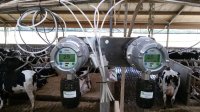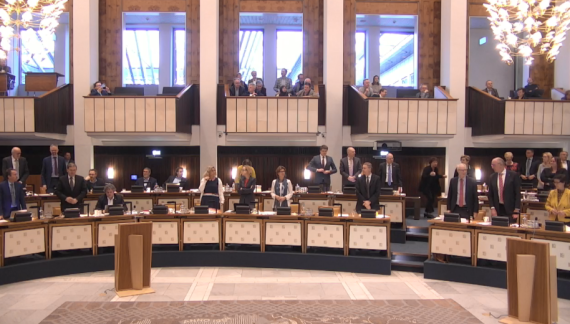The nutrition and health app
Guido Camps, a researcher at Human Nutrition and Health at WUR who works at OnePlanet, wants to make use of the collaboration with Imec to introduce some innovations into the nutrition and health research. Imagine you are keen to know how coronavirus patients, past and present, are faring – how they are feeling, whether their lungs trouble them, whether they are getting any exercise. Such research has always been time-consuming. Researchers have to track down the coronavirus patients, collect contact details, ask questions through questionnaires or phone calls, and feed the answers into a database. Only then can Camps get going on analysing the data.
So in OnePlanet, Camps wants to develop an app that can be used for large-scale research, on the impact of Covid-19, for instance. Patient groups can download the app themselves and fill in their answers. The data are then automatically processed for the researchers by experts from OnePlanet.
Camps is currently working with Imec researchers on the cloud service that will safely store the patients’ data, and on an infrastructure that makes the patients’ answers available to the data analyst in a usable form. The app is still in its infancy. ‘I think it will be ready at the beginning of 2021.’
Camps dreams of an app in which consumers take a photograph of their evening meal every day. ‘Then they send their photos to our database, so we can automatically analyse the image to detect links between diet and health. The tricky thing about this kind of research is that you want to combine different data flows. That is complicated, and it is precisely that process that we want to automatize.’

The ammonia meter
OnePlanet is currently working on a digital platform and a dense network of sensors for the local measurement of nitrogen emissions (NOX and NH3). When the sensors are ready, they will be tested at a number of livestock farms and companies in the province of Gelderland. This will help businesses to identify cost-effective measures with which to halve nitrogen emissions.
Efficient ammonia sensors are essential to a network like this. These sensors establish exactly how much ammonia is produced in livestock barns, how much leaves the barn, and how much ends up in nearby nature areas. Unlike the much-criticized ammonia models, an instrument like this can pinpoint which farms are adhering to the nitrogen norms.
There are already meters that measure the ammonia concentrations in pig and chicken sheds (about 20 parts per million NH3). WUR is now doing research on sensors that can measure lower concentrations (1 to 7 ppm) and can be used in dairy cowsheds. ‘Those will be available in a couple of years,’ estimates WUR researcher Nico Ogink. ‘That kind of sensor needs to be cheap and easy to use, and to measure the ammonia concentration in real time.’
Ogink’s group is now testing a promising sensor produced by the German firm Dräger in about 30 barns. An added advantage of this sensor is that it can withstand long-term exposure to ammonia and dust. But the measurements are not yet precise enough at low concentrations, says Ogink. So the sensor should still be used in combination with reference measurements.
But he would also like to see a sensor become available that can measure very low ammonia concentrations (0.005-0.05 ppm) in the air. And that is what OnePlanet wants to develop now. The technique used by Dräger, an electrochemical cell, may be capable of measuring ammonia in the rural environment as well. ‘The sensor is no more than a building block,’ says WUR’s Jan Vonk. ‘Imec will build the electronics around it, so the signal from the sensor can be converted into usable data even at low concentrations.’ Vonk has no idea when this work will be completed.
The ingestible sensor
‘There are already ingestible thermometers and pills containing a camera,’ says Annelies Goris, programme manager of Precision Health & Nutrition at Imec. ‘But no ingestible sensors yet with which you can monitor the gastro-intestinal tract to detect inflammation, for instance.’ She and her fellow researchers in Wageningen and Nijmegen are now looking at inflammation markers and how they can be measured by an ingestible sensor.
There are some technical challenges to face first, such as how to take measurements in someone’s stomach in real time on a very small sensor surface, how to make sure the sensor gets enough energy, and how to extract the information from the sensor. Here, OnePlanet relies on Imec’s sensor and chip technology. ‘At Imec we have already accrued a knowledge of implantable sensors, and we are working on a wireless energy supply and information transfer system.’
The Nijmegen and Wageningen partners are also thinking about what information they want to get from the gastro-intestinal tract. Medics wants to use the sensor to monitor the gut for inflammation. ‘If they can detect inflammation earlier and more precisely, they can treat it better,’ says Goris. Nutritionists want to know things like how digestion works in the gut, and what effect bacteria have on that.
Goris expects the first version of the ingestible sensor to be ready at the end of this year. ‘Then we will have small sensors, in capsules, and we’ll be able to track their location in the body.’ With all the required safety checks, it will take a few years before there the technology is in use.
| OnePlanet |
|---|
| OnePlanet Research Center was launched in Wageningen and Nijmegen in 2019, and now has about 12 research projects up and running. The innovation platform currently employs about 45 people, and is set to grow to a staff of 120 in the coming years. The knowledge coalition is coordinated by Chris van Hoof (Imec), Thea van Kemenade (Radboud) and Liesbeth Luijendijk (WUR). The main financier is the province of Gelderland. ‘The province will provide the funding for the next eight years, and then its contribution will be cut back rapidly from 100 per cent to 20 per cent of the research costs,’ says Luijkendijk. ‘So we need to find additional funding from external financiers.’ |

 Photo: Shutterstock
Photo: Shutterstock 